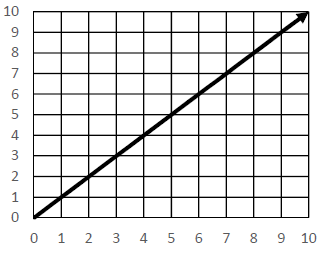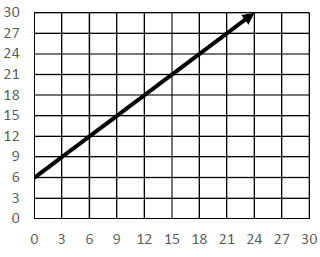PROPORTIONAL RELATIONSHIP
If all the ratios of the variables are equivalent, then those two quantities are in proportional relationship.
In other words, in proportional relationships, one variable is always a constant value times the other variable.
That constant value is called the constant of proportionality.
- Check if the function represents proportional relationship
- Check if the graph represents proportional relationship
- Check from the table
- Check from the statement.
Problem 1 :
Determine if each of the following equations represents a proportional or nonproportional relationship.
(i) d = 65t
(ii) p = 0.1s + 2000
(iii) n = 450 − 3p
(iv) 36 = 12d
A linear relationship is a proportional relationship when y/x is constant. Otherwise, the linear relationship is nonproportional.
Solution :
(i) d = 65t
Since the given equation is in the form of y = kx, it is a proportional relationship.
Constant of proportionality = 65.
(ii) p = 0.1s + 2000
0.1s is added by 2000. So, it is not in proportional relationship.
(iii) n = 450 − 3p
By rewriting as, n = -3p + 450
-3p is added by 450. It is not a proportional relationship.
(iv) 36 = 12d
There is no relationship between two variables. So, there is no proportional relationship.
From the Table
Problem 2 :
Determine if the linear relationship represented by each table is a proportional or nonproportional relationship.
(i)

Solution :
When x = 2, y = 30
Constant of proportionality (k) = y/x
k = 30/2 ==> 15
When x = 8, y = 90
k = 90/8 ==> 45/4
Since constant of proportionality are not equal, it is not in proportional relationship.
(ii)

Solution :
When x = 5, y = 1
Constant of proportionality (k) = y/x
k = 1/5
When x = 40, y = 8
k = 8/40 ==> 1/5
Since constant of proportionality are equal, it is in proportional relationship.
From the Statement
Problem 3 :
Determine which situation is a proportional relationship and which situation is a nonproportional relationship.
(i) The cost for Test Prep Center A is $20 times the number of hours that you attend.
Solution :
Let C be the cost for test preparation center A.
h be the number of hours.
C = 20h
It is a proportional relationship.
(ii) The cost for Test Prep Center B is $25 an hour, but you have a $100 coupon that you can use to reduce the cost.
Solution :
C = 100 - 25h
It is non proportional relationship.
From the Graph
Problem 4 :
Determine if each relationship is a proportional or nonproportional situation.
(i)

Solution :
Since the line passes through the origin, it is a proportional relationship.
(ii)

Solution :
Since the line does not passes through the origin, it is a non proportional relationship.
Recent Articles
-
Finding Range of Values Inequality Problems
May 21, 24 08:51 PM
Finding Range of Values Inequality Problems -
Solving Two Step Inequality Word Problems
May 21, 24 08:51 AM
Solving Two Step Inequality Word Problems -
Exponential Function Context and Data Modeling
May 20, 24 10:45 PM
Exponential Function Context and Data Modeling